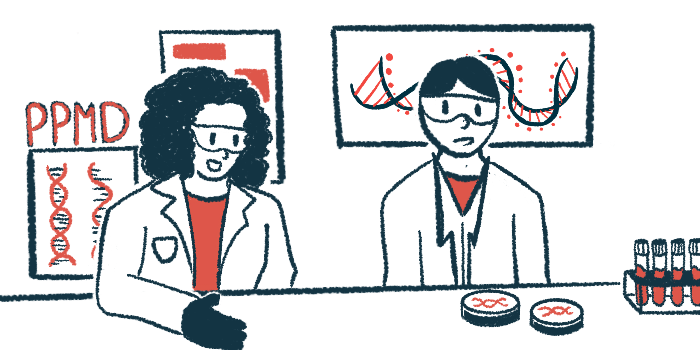PPMD 2024: 4 therapies aiming to slow DMD progression now in trials
All aim to modulate biological processes surrounding muscle damage

Four experimental treatments — deramiocel, sevasemten, satralizumab, and tadalafil — all in clinical testing and all aiming to slow the progression of Duchenne muscular dystrophy (DMD), were spotlighted in a session at last week’s Parent Project Muscular Dystrophy (PPMD) conference.
In Duchenne MD, mutations lead to a lack of functional dystrophin, a protein that normally helps protect muscles from damage. That lack of dystrophin causes muscles to accumulate more wear and tear over time, ultimately resulting in DMD symptoms.
Some DMD treatment strategies, such as exon-skipping and gene therapy, aim to target the disease’s root cause by boosting levels of functional dystrophin protein. But the four therapies discussed at this talk instead aim to slow disease progression by modulating biological processes that surround muscle damage. One such process is inflammation.
According to researchers involved in the development of these four therapies, all have shown promise for slowing DMD progression and improving patients’ health.
Dramiocel is designed to promote muscle health
Deramiocel, previously called CAP-1002, is a cell therapy containing immature heart cells that are able to release signaling molecules to promote muscle health.
“These cells have multiple modalities. They have immunomodulatory properties, they have anti-inflammatory properties, they have antifibrotic [scarring] properties,” said Mark Awadalla, vice president of clinical operations at Capricor Therapeutics, the company developing deramiocel.
In the Phase 2 HOPE-2 trial (NCT03406780), 13 DMD patients were given deramiocel or a placebo for one year. Then, after a gap of about a year, participants could enter into an open-label extension (NCT04428476) in which all are being treated with deramiocel and monitored for long-term outcomes. Deramiocel has overall been well tolerated in the study, with no serious side effects reported so far.
Three-year data from the extension study have indicated that arm and hand function — measured by a test called the Performance of Upper Limb (PUL) — worsened more slowly with deramiocel treatment. In the patients’ first year on the cell therapy, PUL scores worsened by about 1.7 points on average. In the second year, average scores worsened by 1.2 points, and in the third year by just 1 point.
These data indicate that the progression of arm weakness is “slowing down a little bit,” Awadalla said, noting that these trends are not what’s typically seen in DMD. A comparison with data from an external group of DMD patients who did not get deramiocel showed PUL scores worsened much more quickly among them over three years, such that patients on deramiocel on average had 47% slower progression.
Measures of heart function, such as the left ventricular ejection fraction (LVEF), have tended to improve after three years on deramiocel. For context, natural history data indicates that LVEF usually gets worse over time in people with DMD. Awadalla noted that these measurements of heart health are closely linked with mortality risk.
Top-line results from the Phase 3 HOPE-3 trial (NCT05126758) testing deramiocel in DMD are expected later this year, and Capricor will soon be meeting with the U.S. Food and Drug Administration to discuss plans for the therapy’s future development.
Sevasemten aims to make muscle movements gentler
Sevasemten, previously called EDG-5506, is designed to block the activity of myosin, a protein involved in muscle contractions. The therapy aims to make muscle movements gentler so that muscles don’t accumulate as much damage over time.
Edgewise Therapeutics is developing sevasemten to treat both DMD and Becker muscular dystrophy (BMD), a rarer disorder that’s also marked by dystrophin dysfunction. The company recently announced two-year data from the Phase 1 ARCH trial (NCT05160415), which tested sevasemten in adults with BMD, showing the therapy overall was well tolerated and appeared to stabilize muscle function compared with what would be expected without treatment.
A Phase 2 trial of sevasemten in BMD, called CANYON (NCT05291091), and its expansion GRAND CANYON, are ongoing.
Edgewise also is running two other trials to test the therapy in people with DMD: FOX (NCT06100887) and LYNX (NCT05540860). FOX is testing sevasemten in DMD boys who were previously treated with gene therapy, while LYNX is evaluating the treatment in ambulatory boys who have not had gene therapy but may have had other treatments like exon-skipping therapy. FOX has finished enrollment. LYNX is still enrolling boys ages 4 through 9 at more than a dozen sites in the U.S.
Satralizumab aims to preserve muscle, bone health in DMD
An anti-inflammatory treatment, Satralizumab works by blocking an inflammatory signaling molecule called interleukin-6 (IL-6). Satralizumab is approved under the name to treat the autoimmune disease neuromyelitis optica spectrum disorder, and its safety profile is well-documented. Common side effects from the subcutaneous, or under-the-skin, injection therapy include headache, joint pain, low white blood cell counts, and injection reactions.
Satralizumab’s developer Roche is planning to test whether the anti-inflammatory treatment may help preserve muscle and bone health in DMD patients, given that IL-6 is involved in the inflammation that drives bone and muscle damage in DMD.
“This is our hypothesis … by blocking this hyperactive signal of IL-6, [satralizumab] might be able to reduce damage to the bones and reduce damage to the muscles,” said Maitea Guridi, PhD, global development leader at Roche.
An upcoming open-label Phase 2 study called SHIELD DMD (NCT06450639) aims to test satralizumab in ambulatory and nonambulatory boys with DMD, ages 8 to 15. The trial will evaluate the therapy’s effects on markers of muscle and bone health. Patients who have taken exon-skipping or gene therapies are not eligible, though participants in SHIELD DMD may be allowed to start those medicines after the first year on satralizumab in the trial.
This is our hypothesis … by blocking this hyperactive signal of IL-6, [satralizumab] might be able to reduce damage to the bones and reduce damage to the muscles.
The study, which will be conducted at sites in the U.S., Italy, Poland, and Spain, is expected to start recruiting patients in August or September.
“We’re currently working very hard with the investigators to get their sites ready to start enrolling,” Guridi said. “We’re hoping to enroll and recruit the first participant in SHIELD DMD by the end of this summer.”
Tadalafil could stave off muscle damage by increasing blood flow
Tadalafil is a blood pressure medication most famous for being the active agent in Cialis, a medicine approved to treat erectile dysfunction. Formulations of tadalafil also are approved to treat a form of pulmonary hypertension. The therapy works to increase blood flow by relaxing blood vessels. In DMD, increasing blood flow to muscles could help stave off damage by making sure muscles have ample nutrients and oxygen.
A Phase 3 trial in 2017 showed the treatment failed to best a placebo at slowing decline in measures of walking ability, though assessments of arm function showed some trends toward stabilization with the therapy.
According to Tanja Taivassalo, PhD, a professor at the University of Florida, these mixed results may be explained because, based on data from preclinical studies, “tadalafil really only works when muscles are active.” Because the Phase 3 trial included a range of disease severities, it’s likely many patients just weren’t using their legs enough to see a notable benefit in walking abilities, whereas arms might be more active and therefore more likely to show an effect.
If that’s true, then it follows logically that tadalafil would be most effective when given in combination with regular exercise. To test that idea, Taivassalo and colleagues are now running an exploratory trial called VASO-REx (NCT06290713).
The just-launched study will enroll ambulatory boys with DMD, ages 6 and older; recruitment is ongoing at a site in Gainesville, Florida. Participants will first be tested to see if they respond to tadalafil treatment with increased muscle blood flow as expected. Then, responders will be assigned to take tadalafil or a placebo while undergoing an exercise regime of cycling four times weekly for six months. The main goal is to assess how the therapy affects blood flow and measures of fatigue.
Note: The Muscular Dystrophy News Today team is providing virtual coverage of the Parent Project Muscular Dystrophy Annual Conference (PPMD) June 27-29. Go here to see the latest stories from the conference.










